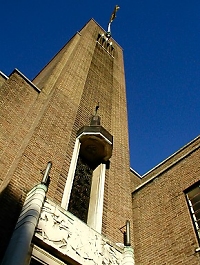|
A fashionable Victorian suburb centred around a confluence of routes a mile south-west of Hornsey. The name is of Middle English
origin, an ‘end’ being an outlying place, while a ‘crouch’ was a cross, which may have been placed
here as a boundary post between two manors. During the late 18th century the village took shape as a congregation of labourers’
cottages, though there were grander houses in the vicinity – two of which were later acquired by the Booths, the gin
distilling family. The Hornsey enclosure award of 1813 prompted a gradual programme of housebuilding that accelerated rapidly
after the opening of Crouch Hill and Crouch End stations in the late 1860s. The latter is now closed and its disused line
has become the Parkland Walk that traverses the district. During the 1870s and 1880s, Crouch End was entirely built over,
with pressure from local worthies ensuring a high standard of construction. Civic pride shows in Crouch End’s landmark,
a clock tower erected by public subscription in 1895. A few post-war office blocks have marred its homogeneity, but Crouch
End remains one of London’s lovelier suburbs, with an eclectic selection of shops and restaurants in the streets converging
on the Broadway – also the location of Hornsey town hall (shown below), an award winner when it was built in 1935. Hornsey
College of Art, attended by the Kinks’ frontman Ray Davies, later became the TUC College and now accommodates yet more
Haringey council staff. A remarkable number of 1960s pop stars went on to buy homes in Crouch End and the area has acquired
quasi-cult status among mid-ranking media personalities. The most prominent of recent developments has been the replacement
of the old telephone exchange by an apartment complex with a fitness centre and a Marks and Spencer food store at street level.
 |

